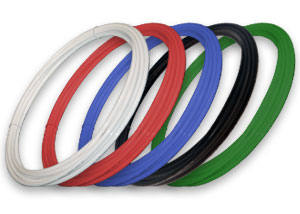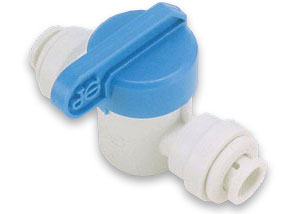Acidity (pH Balance)
Source: Chemistry.about.comAlthough the pH of pure water is 7, drinking water and natural water exhibits a pH range because it contains dissolved minerals and gases. Surface waters typically range from pH 6.5 to 8.5 while groundwater ranges from pH 6 to 8.5. Water with a pH less than 6.5 is considered acidic. This water typically is corrosive and soft. It may contain metal ions, such as copper, iron, lead, manganese and zinc. The metal ions may be toxic, may produce a metallic taste, and can stain fixtures and fabrics. The low pH can damage metal pipes and fixtures.
Water with a pH higher than 8.5 is considered basic or alkaline. This water often is hard water, containing ions that can form scale deposits in pipes and contribute an alkali taste.
Products that Balance pH
Pentek Inline pH Stabilizers Well Water Acid Neutralizing Systems Corosex MediaArsenic
(Source: nsf.org)Arsenic can be found in water in two different forms:
- Pentavalent Arsenic (also known as Arsenic 5, Arsenic V, or Arsenate)
- Trivalent Arsenic (also known as Arsenic 3, Arsenic III, or Arsenite)
From NSF.org
NSF/ANSI Standard 53: Drinking Water Treatment Units – Health Effects
Overview: Standard 53 addresses point-of-use (POU) and point-of-entry (POE) systems designed to reduce specific health-related contaminants, such as Cryptosporidium, Giardia, lead, volatile organic chemicals (VOCs), MTBE (methyl tertiary-butyl ether), that may be present in public or private drinking water.
NSF/ANSI Standard 58: Reverse Osmosis Drinking Water Treatment Systems
Overview: This standard was developed for point-of-use (POU) reverse osmosis (RO) treatment systems. These systems typically consist of a pre-filter, RO membrane, and post-filter. Standard 58 includes contaminant reduction claims commonly treated using RO, including fluoride, hexavalent and trivalent chromium, total dissolved solids, nitrates, etc. that may be present in public or private drinking water.
NSF/ANSI Standard 62: Drinking Water Distillation Systems
Overview: Standard 62 covers distillation systems designed to reduce specific contaminants, including total arsenic, chromium, mercury, nitrate/nitrite, and microorganisms from public and private water supplies.
Products that Remove Arsenic
Reverse Osmosis Water Filters Under Sink Water Filters Countertop Water Filters Whole House Water Filters Everpure Systems and Cartridges Carbon Block Cartridges Granular Activated Carbon Cartridges Aries Filter Works Arsenic Removal CartridgesBacteria & Viruses
Water suppliers use disinfectants, like chlorine, to destroy pathogens (disease-causing organisms) from drinking water. However some pathogens are highly resistant to standard disinfection methods (such as Cryptosporidium).
Filtration has a high effectiveness in removing Cryptosporidium when using an absolute less than or equal to 1 micron filter (NSF Standard 53 or 58 rated “cyst reduction / removal” filter).
From NSF.org
NSF/ANSI Standard 53: Drinking Water Treatment Units
Overview: Standard 53 addresses point-of-use (POU) and point-of-entry (POE) systems designed to reduce specific health-related contaminants, such as Cryptosporidium, Giardia, lead, volatile organic chemicals (VOCs), MTBE (methyl tertiary-butyl ether), that may be present in public or private drinking water.
NSF/ANSI Standard 58: Reverse Osmosis Drinking Water Treatment Systems
Overview: This standard was developed for point-of-use (POU) reverse osmosis (RO) treatment systems. These systems typically consist of a pre-filter, RO membrane, and post-filter. Standard 58 includes contaminant reduction claims commonly treated using RO, including fluoride, hexavalent and trivalent chromium, total dissolved solids, nitrates, etc. that may be present in public or private drinking water.
Products that Remove or Kill Bacteria
Ultraviolet Purification Systems Doulton Ceramic Filters Reverse Osmosis Water Filters Under Sink Water Filters Countertop Water Filters Whole House Water Filters Everpure Systems and CartridgesChloramines
Systems and cartridges containing activated carbon are able to remove the odor and taste caused by chlorine and chloramines, due to it being extremely porous by having a large surface area. Chloramine removal cartridges provides greater chloramine performance capacities than granular activated carbon.
From NSF.org
NSF/ANSI Standard 42: Drinking Water Treatment Units – Aesthetic Effects
Overview: This standard covers point-of-use (POU) and point-of-entry (POE) systems designed to reduce specific aesthetic or non-health-related contaminants (chlorine, taste and odor, and particulates) that may be present in public or private drinking water.
Products that Reduce or Remove Chloramines
Reverse Osmosis Water Filters Chloramine Removal CartridgesChlorine
Systems and cartridges containing activated carbon are able to remove the odor and taste caused by chlorine and chloramines, due to it being extremely porous by having a large surface area. Carbon block cartridges, granular activated carbon cartridges, Aries Filter Works cartridges, countertop, Everpure, and whole house systems, shower head filters and some of our filtration medias & resins.
From NSF.org
NSF/ANSI Standard 42: Drinking Water Treatment Units – Aesthetic Effects
Overview: This standard covers point-of-use (POU) and point-of-entry (POE) systems designed to reduce specific aesthetic or non-health-related contaminants (chlorine, taste and odor, and particulates) that may be present in public or private drinking water.
Products that Reduce or Remove Chlorine
Reverse Osmosis Water Filters Under Sink Water Filters Countertop Water Filters Whole House Water Filters Shower Head Filters Everpure Systems and Cartridges Carbon Block Cartridges Granular Activated Carbon CartridgesFluoride
Reverse Osmosis is the best way to remove fluoride from drinking water. Thin Film Composite Reverse Osmosis Membranes remove between 85-92% of Fluoride.
Aries Filter Works Fluoride reduction cartridges contain Resintech SIR-900, in which fluoride is removed by a chemical reaction with the media. The process is flow and pH sensitive. The best results are obtained when the flow is limited to about l GPM/cu.ft. and the pH is held at 5.5. Higher flows and higher or lower pH causes a significant loss of capacity. The best capacity obtainable is approximately 0.2 lbs. per cu.ft. Leakage of fluoride is generally less than 0.1 mg./L to breakthrough.
From NSF.org
NSF/ANSI Standard 53: Drinking Water Treatment Units – Health Effects
Overview: Standard 53 addresses point-of-use (POU) and point-of-entry (POE) systems designed to reduce specific health-related contaminants, such as Cryptosporidium, Giardia, lead, volatile organic chemicals (VOCs), MTBE (methyl tertiary-butyl ether), that may be present in public or private drinking water.
NSF/ANSI Standard 58: Reverse Osmosis Drinking Water Treatment Systems
Overview: This standard was developed for point-of-use (POU) reverse osmosis (RO) treatment systems. These systems typically consist of a pre-filter, RO membrane, and post-filter. Standard 58 includes contaminant reduction claims commonly treated using RO, including fluoride, hexavalent and trivalent chromium, total dissolved solids, nitrates, etc. that may be present in public or private drinking water.
NSF/ANSI Standard 62: Drinking Water Distillation Systems
Overview: Standard 62 covers distillation systems designed to reduce specific contaminants, including total arsenic, chromium, mercury, nitrate/nitrite, and microorganisms from public and private water supplies.
Products that Reduce or Remove Fluoride
Reverse Osmosis Water Filters Under Sink Water Filters (UCF Models Only) Aries Filter Works Fluoride Reduction CartridgesIron
Iron poses no health hazards but can but can cause water to have an unaesthetic, reddish brown color and can cause staining. Well water systems using Filox and Polyphosphate cartridges can remove excess amounts of iron from water. Water softener systems can reduce iron (excluding dissolved organic-iron compounds) to low levels by ion exchange. Aries Filter Works also has cartridges specifically for the removal of heavy metals and also cartrides containing KDF85, which is used for the reomval of iron and sulfur from water.
Products that Reduce or Remove Iron
Filox Well Water Systems (Removal) Water Softeners (Reduction) Aries KDF85 / GAC Cartridges (Removal) Aries Heavy Metal Removal CartridgesLead
Lead has been mined and used by humans for thousands of years and was only recently discovered in the last few decades. Lead can accumulate in the body’s soft tissue and bones and cause poisoning, disrupt body processes, and is toxic to many internal organs. Symptoms of lead poisoning are irritability, confusion, headaches, abdominal pain and comas, seizures & even death in extreme cases.
“ There is no known safe level of exposure to lead.”
Infants and small children are at greater risk due to being constantly developing and higher absorption from a smaller body mass. Lead is particularly damaging to the nervous system, which can cause learning and behavior disorders. Pregnant mothers with high blood lead content may cause poisoning in infants, and are more likely to have a low birth weight or premature birth.
Products that Reduce or Remove Lead
Reverse Osmosis Water Filters Everpure Systems and Cartridges Aries Filter Works Cartridges KDF Filters Under Sink Filters with Lead RemovalMercury
Boiling your water will not remove mercury from it. Most systems with thin film composite membranes or filters containing KDF media will reduce mercury levels in drinking water, like reverse osmosis, under sink, and most Everpure systems. There is also specialty cartridges and filters made to complete remove mercury from drinking water, the types we carry are listed below.
From NSF.org
NSF/ANSI Standard 53: Drinking Water Treatment Units – Health Effects
Overview: Standard 53 addresses point-of-use (POU) and point-of-entry (POE) systems designed to reduce specific health-related contaminants, such as Cryptosporidium, Giardia, lead, volatile organic chemicals (VOCs), MTBE (methyl tertiary-butyl ether), that may be present in public or private drinking water.
NSF/ANSI Standard 58: Reverse Osmosis Drinking Water Treatment Systems
Overview: This standard was developed for point-of-use (POU) reverse osmosis (RO) treatment systems. These systems typically consist of a pre-filter, RO membrane, and post-filter. Standard 58 includes contaminant reduction claims commonly treated using RO, including fluoride, hexavalent and trivalent chromium, total dissolved solids, nitrates, etc. that may be present in public or private drinking water.
NSF/ANSI Standard 62: Drinking Water Distillation Systems
Overview: Standard 62 covers distillation systems designed to reduce specific contaminants, including total arsenic, chromium, mercury, nitrate/nitrite, and microorganisms from public and private water supplies.
Products that Remove Mercury
Reverse Osmosis Systems Everpure Systems and Cartridges Aries Filter Works Cartridges KDF FiltersNitrites
Reverse Osmosis Systems can remove nitrites from water with a thin-film membrane, a process known as membrane separation. Thin-film membranes only allow pure water to pass through. Contaminants are rejected away and flushed to the drain. Membranes remove contaminants as small as .0001 micron.
From NSF.org
NSF/ANSI Standard 53: Drinking Water Treatment Units – Health Effects
Overview: Standard 53 addresses point-of-use (POU) and point-of-entry (POE) systems designed to reduce specific health-related contaminants, such as Cryptosporidium, Giardia, lead, volatile organic chemicals (VOCs), MTBE (methyl tertiary-butyl ether), that may be present in public or private drinking water.
NSF/ANSI Standard 58: Reverse Osmosis Drinking Water Treatment Systems
Overview: This standard was developed for point-of-use (POU) reverse osmosis (RO) treatment systems. These systems typically consist of a pre-filter, RO membrane, and post-filter. Standard 58 includes contaminant reduction claims commonly treated using RO, including fluoride, hexavalent and trivalent chromium, total dissolved solids, nitrates, etc. that may be present in public or private drinking water.
NSF/ANSI Standard 62: Drinking Water Distillation Systems
Overview: Standard 62 covers distillation systems designed to reduce specific contaminants, including total arsenic, chromium, mercury, nitrate/nitrite, and microorganisms from public and private water supplies.
Products that Remove Nitrites
Reverse Osmosis SystemsSand & Sediment
Sediment is the most common problem in water filtration, so almost all of the water filtration systems we offer has a filter or stage to deal with it. Sediment cartridges come in several types (pleated, melt blown, string wound and high temperature) and, like their name suggests, remove sediment from water.
Products that Remove Sediment
Reverse Osmosis Systems Under Sink Systems Countertop Systems Gravity Filter Systems Everpure Systems Whole House Systems Commercial Filtration SystemsOther Contaminants
There are many other types of contaminants that can be found in water supplies. Reverse osmosis systems remove a wide range of these contaminants in water and the cartridges in each stage can be changed to customize what it filters out.
Contact our office at 1-800-955-8561 for more information on removal of a specific contaminant.
Contaminants & Health Effects Contaminants Removed by Reverse Osmosis















































